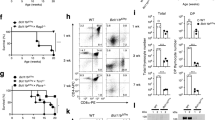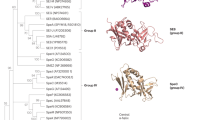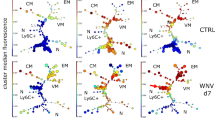Abstract
CLONAL deletion or clonal anergy establish tolerance in T cells that bear potentially autoreactive antigen receptors1–15. Here we report that concomitant infection with the nematode Nippostron-gylus brasiliensis breaks an established T-cell tolerance induced by injection of mice with Staphylococcus enterotoxin B (SEB)16,17. CD4+ T cells from SEB-tolerant mice did not produce either interleukin-2 or interleukin-4 when challenged in vitro with SEB. N. brasiliensis infection of SEB-primed animals resulted in a normal expansion of SEB-tolerant CD4+Vβ8+ T cells in vivo as well as an equivalent increase of SEB-reactive, interleukin-4-producing CD4+Vβ8+ T cells both in SEB-tolerant and in normal animals. Thus, infection with N. brasiliensis circumvented the tolerance established with SEB. Activation of anergic, potentially autoreactive CD4+ T cells by infectious agents seems to be a major pathway for the initiation of autoimmune diseases15. Our results suggest that infectious agents may break tolerance in potentially autoreactive CD4+ T cells by activation of alternative reaction pathways.
This is a preview of subscription content, access via your institution
Access options
Subscribe to this journal
Receive 51 print issues and online access
$199.00 per year
only $3.90 per issue
Buy this article
- Purchase on Springer Link
- Instant access to full article PDF
Prices may be subject to local taxes which are calculated during checkout
Similar content being viewed by others
References
Kappler, J. W., Staerz, U., White, J. & Marrack, P. C. Nature 332, 35–40 (1988).
MacDonald, H. R. et al. Nature 332, 40–45 (1988).
Kisielow, P., Blüthmann, H., Staerz, U. D., Steinmetz, M. & von Boehmer, H. Nature 333, 742–746 (1988).
Smith, H., Chen, I.-M., Kubo, R. & Tung, K. S. K. Science 245, 749–752 (1989).
Ramsdell, F., Lantz, T. & Fowlkes, B. J. Science 246, 1038–1041 (1989).
Fry, A. M., Jones, L. A., Kruisbeek, A. M. & Matis, L. A. Science 246, 1044–1046 (1989).
Hodes, R. J., Sharrow, S. O. & Solomon, A. Science 246, 1041–1044 (1989).
Blackman, M. A. et al. Nature 345, 540–542 (1990).
Yui, K., Komori, S., Katsumata, M., Siegel, R. M. & Greene, M. I. Proc. natn. Acad. Sci. U.S.A. 87, 7135–7139 (1990).
Speiser, D. E., Chvatchko, Y., Zinkernagel, R. M. & MacDonald, H. R. J. exp. Med. 172, 1305–1314 (1990).
Burkly, L. C., Lo, D., Kanagawa, O., Brinster, R. L. & Flavell, R. A. Nature 342, 564–566 (1989).
Murphy, K. M., Weaver, C. T., Elish, M., Allen, P. M. & Loh, D. Y. Proc. natn. Acad. Sci. U.S.A. 86, 10034–10038 (1989).
Schwartz, R. H. Science 248, 1349–1356 (1990).
Sprent, J., Gao, E.-K. & Webb, S. R. Science 248, 1357–1363 (1990).
Sinha, S. A., Lopez, M. T. & McDevitt, H. O. Science 248, 1380–1388 (1990).
Rellahan, B. L., Jones, L. A., Kruisbeek, A. M., Fry, A. M. & Matis, L. A. J. exp. Med. 172, 1091–1100 (1990).
Kawabe, Y. & Ochi, A. Nature 349, 245–248 (1991).
White, J. et al. Cell 56, 27–35 (1989).
Qin, S., Cobbold, S., Benjamin, R. & Waldmann, H. J. exp. Med. 169, 779–894 (1989).
Rammensee, H.-G., Kroschewski, R. & Frangoulis, B. Nature 339, 541–544 (1989).
Webb, S., Morris, C. & Sprent, J. Cell 63, 1249–1256 (1990).
Finkelman, F. D. et al. Proc. natn. Acad. Sci. U.S.A. 83, 9675–9678 (1986).
Ben-Sasson, S. Z., Le Gros, G., Conrad, D. H., Finkelman, F. D. & Paul, W. E. J. Immun. 145, 1127–1136 (1990).
Goldman, M., Druet, P. & Gleichmann, E. Immun. Today 12, 223–227 (1991).
Ohashi, P. S. et al. Cell 65, 305–317 (1991).
Röcken, M. et al. J. Immun. 148, 47–54 (1992).
Staerz, U. D., Rammensee, H-G., Benedetto, J. D. & Bevan, M. J. Immun. 134, 3994–4000 (1985).
Hu-Li, J., Ohara, J., Watson, C., Tsang, W. & Paul, W. E. J. Immun. 142, 800–807 (1989).
Ohara, J. & Paul, W. E. Nature 315, 333–336 (1985).
Author information
Authors and Affiliations
Rights and permissions
About this article
Cite this article
Röcken, M., Urban, J. & Shevach, E. Infection breaks T-cell tolerance. Nature 359, 79–82 (1992). https://doi.org/10.1038/359079a0
Received:
Accepted:
Issue Date:
DOI: https://doi.org/10.1038/359079a0
This article is cited by
-
Immune characteristics associated with lymph node metastasis in early-stage NSCLC
Cellular Oncology (2023)
-
The Three Dimensions of Functional T-Cell Tolerance: From Research to Practice
Journal of Investigative Dermatology (2012)
-
Autoantibodies to GPI in rheumatoid arthritis: linkage between an animal model and human disease
Nature Immunology (2001)
-
Immunological adjuvants promote activated T cell survival via induction of Bcl-3
Nature Immunology (2001)
-
Maintenance and loss of self-tolerance in B cells
Springer Seminars in Immunopathology (2001)
Comments
By submitting a comment you agree to abide by our Terms and Community Guidelines. If you find something abusive or that does not comply with our terms or guidelines please flag it as inappropriate.



